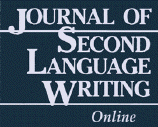|
|
|
The Journal of Second
Language Writing is devoted to publishing theoretically grounded reports
of research and discussions of central issues in second and foreign language
writing and writing instruction. Some areas of interest are personal
characteristics and attitudes of L2 writers, L2 writers' composing
processes, features of L2 writers' texts, readers' responses to L2 writing,
assessment/evaluation of L2 writing, contexts (cultural, social, political,
institutional) for L2 writing, and any other topic clearly relevant to L2
writing and/or writing instruction. Responses to published articles are
also welcome for the Dialogue section of the journal. The Journal
of Second Language Writing is published four times a year.
Manuscripts are accepted for review with the understanding that the work
has not been and will not be published nor is presently submitted elsewhere,
that all persons listed as authors have given their approval for the
submission of the paper, and that any person cited as a source of personal
communication has approved such citation.
Authors submitting a manuscript do so on the understanding that, if it is
accepted for publication, copyright of the article, including the right to
reproduce the article in all forms and media, shall be assigned exclusively
to the Publisher. The Publisher will not refuse any reasonable request by
the author for permission to reproduce any of his or her contributions to
the Journal of Second Language Writing.
Guidelines for Submission
- Manuscript Preparation: Submissions should be between 15-30
pages in length, typed, double-spaced on one side of 8 1/2 x 11 inch
paper, and include a 200 word abstract and a short (50-100 word) bio
statement.
- Manuscript Submission: Four copies of the manuscript,
accompanied by a cover letter which includes the author's (or authors')
name, affiliation, address, home and office phone and fax numbers and
e-mail address, should be submitted to Ilona Leki, Journal of Second
Language Writing, Department of English, 301 McClung Tower, University
of Tennessee, Knoxville, TN 37996-0430.
- Style: The style guidelines of the Publication Manual of the
American Psychological Association (4th ed., 1994) should be followed,
especially for reference lists and text citation of sources (see
References below).
- Review: Since manuscripts are submitted for blind review, all
identifying information should be removed from the body of the paper.
- Tables and Figures: Tables and figures should be completely
understandable, independent of the text, and camera ready.
- Notes: Endnotes should be used sparingly and numbered
consecutively.
- References:
All sources cited in text must be included alphabetically in the reference
list. Below are examples of entries for, respectively, a paper presented
at a meeting, a journal article, a book, and an article in an edited book.
Caldwell, K., Marshall, H. W., Noji, F., & Wald, M. (2001, March). Instructional
strategies for Generation 1.5. Paper presented at the 35th annual
convention of TESOL, ST. Louis, MO.
Harklau,
L. (2000). From the "good kids" to the "worst": Representations of English
language learners across educational settings. TESOL Quarterly, 34, 35-67.
Canagarajah,
S. (2002). The geopolitics of academic writing. Pittsburgh:
University of Pittsburgh Press.
Li,
X. (1999). Writing from the vantage point of an outsider/insider. In
G. Braine (Ed.), Non-native educators in English language teaching (pp.
43-55). Mahwah, NJ: Lawrence Erlbaum Associates.
- Permissions: Copies of any letters granting permission to
reproduce illustrations, tables, or lengthy quoted passages are the
authors' responsibility and should be submitted with the manuscript.
- Copyright and Disk: Upon acceptance the authors will assign
copyright to Elsevier Science Inc. and supply an IBM compatible disk,
spell checked and stripped of all embedded graphics. Graphics should be
saved in a separate file as an eps or tiff file. Text files should be
saved in MS Word or WordPerfect.
- Offprints: Each lead author will receive fifty offprints free
of charge. Additional offprints may be ordered when page proofs are
returned.
- Author Enquiries: Authors can keep track of the progress of
their accepted article, and set up e-mail alerts informing them of changes
to their manuscript's status, by using the "Track a Paper" feature of
Elsevier's Author Gateway (http://www.authors.elsevier.com). Full details
for the electronic submission of artwork can be obtained from http://www.elsevier.com/locate/authorartwork/.
Contact details for questions arising after acceptance of an article,
especially those relating to prrofs, are provided when an article is
accepted for publication. Elsevier author support may be contacted at:
authorsupport@elsevier.ie. The website for the JSLW is http://www.jslw.org/.
Submissions to Dialogue Section
- Manuscript Preparation: Submission should
be less than 10 pages in lengths, typed, double-spaced on one side
of 8 1/2 x 11 inch paper.
- Manuscript Submission: Two copies of
the manuscript should be submitted with the same stipulation as for
full length manuscripts.
|

